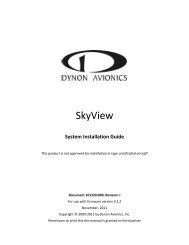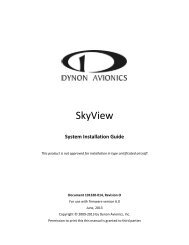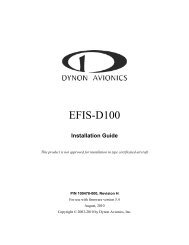EFIS-D60 Installation Guide - Dynon Avionics
EFIS-D60 Installation Guide - Dynon Avionics
EFIS-D60 Installation Guide - Dynon Avionics
You also want an ePaper? Increase the reach of your titles
YUMPU automatically turns print PDFs into web optimized ePapers that Google loves.
2. WIRING OVERVIEWPlease follow these instructions explicitly as improper wiring can result in permanent damage toyour instrument and/or the accompanying sensors.All electrical power and <strong>EFIS</strong>-specific lines interface with the <strong>EFIS</strong>-<strong>D60</strong> via the female 25-pinD-sub connector on the back of the instrument. Ensure that the unit powers on and that allindicators display expected values before completing the final physical assembly.Recommended Wiring PracticesFor all electrical connections, use correct wiring techniques, taking care to properlyinsulate any exposed wire. A short circuit between any of the wires may cause damage tothe <strong>EFIS</strong>-<strong>D60</strong> and/or your aircraft. Make all connections to your harness before pluggingit into any of the components of the system. Do not make connections while power isapplied at any point in the system.<strong>Dynon</strong> <strong>Avionics</strong> sells a wiring harness for all connections to the <strong>EFIS</strong>-<strong>D60</strong>. The harness is madeup of 22 AWG wire and meets Mil Standard MIL-W-22759/16 (Tefzel insulation). If you haveopted not to purchase this harness, please refer to the provided wiring diagrams for constructioninformation. We recommend that all wire you use also meets Mil Standard MIL-W-22759/16; allwire supplied by <strong>Dynon</strong> <strong>Avionics</strong> (with the exception of thermocouple wire, which uses FEPinsulation) meets this specification.When using any pre-manufactured harness, verify that each pin has continuity with the expectedwire on the wiring diagram. This test can be easily done with a multimeter. When verifyingharnesses, use the wiring charts and diagrams in this guide as your ultimate authority on pinfunction (for any harness) and wire color (for harnesses purchased from <strong>Dynon</strong> <strong>Avionics</strong>).Route all wiring such that there are no spots where it could chafe or break. Use appropriate strainrelief at all junctions between wires and connectors. We recommend that you secure all wires atregular intervals along wiring runs to accommodate vibration effects.All connections on the <strong>EFIS</strong> female 25-pin harness are described in the Instrument <strong>Installation</strong>section on page 3-1.Power Requirements22 AWG wire is normally sufficient for the power supply and ground lines, but we recommendthat you consult a wire sizing chart and determine the size required for the wire routing in yourparticular aircraft. Ensure that the power lines include a circuit breaker or an appropriately sizedfuse for the wire you select. Power is fed to the <strong>EFIS</strong>-<strong>D60</strong> via pins in the female D-25 connectoras shown on the 25-Pin Female <strong>EFIS</strong> Harness diagram on page 2-2.The <strong>EFIS</strong>-<strong>D60</strong> system-wide power requirement is 12 watts typical and 17 watts maximum. On a12-volt system, this translates to about 1.5 amps of maximum current draw. On a 24-volt system,this translates to about 0.75 amps maximum current draw. Normally, a 3-amp circuit breaker orfuse is sufficient.<strong>EFIS</strong>-<strong>D60</strong> <strong>Installation</strong> <strong>Guide</strong> 2-1
















